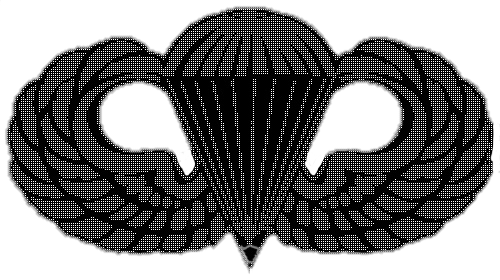A Twitter friend and I were talking a few months ago, and he described to me an event he thought I might be interested in attending. He said there was a race, similar to a Tough Mudder, but with guns. He was right, I was immediately curious.
The April 10th North Carolina Gun Run was a two gun, centerfire biathlon covering ~5 kilometers (I've seen estimates that this race was actually a 6k). The race went along some hardball and dirt roads but was somewhat cross-country and featured six shooting stages. These stages were more immersive than simple draw and shoot or the flat range firing most of us are accustomed to performing. Everything had a time component and was scored regardless of experience, equipment, gender, age, weight, etc. Each shooter carried what kit they considered prudent and following the required safety precautions, how they wished to carry it.
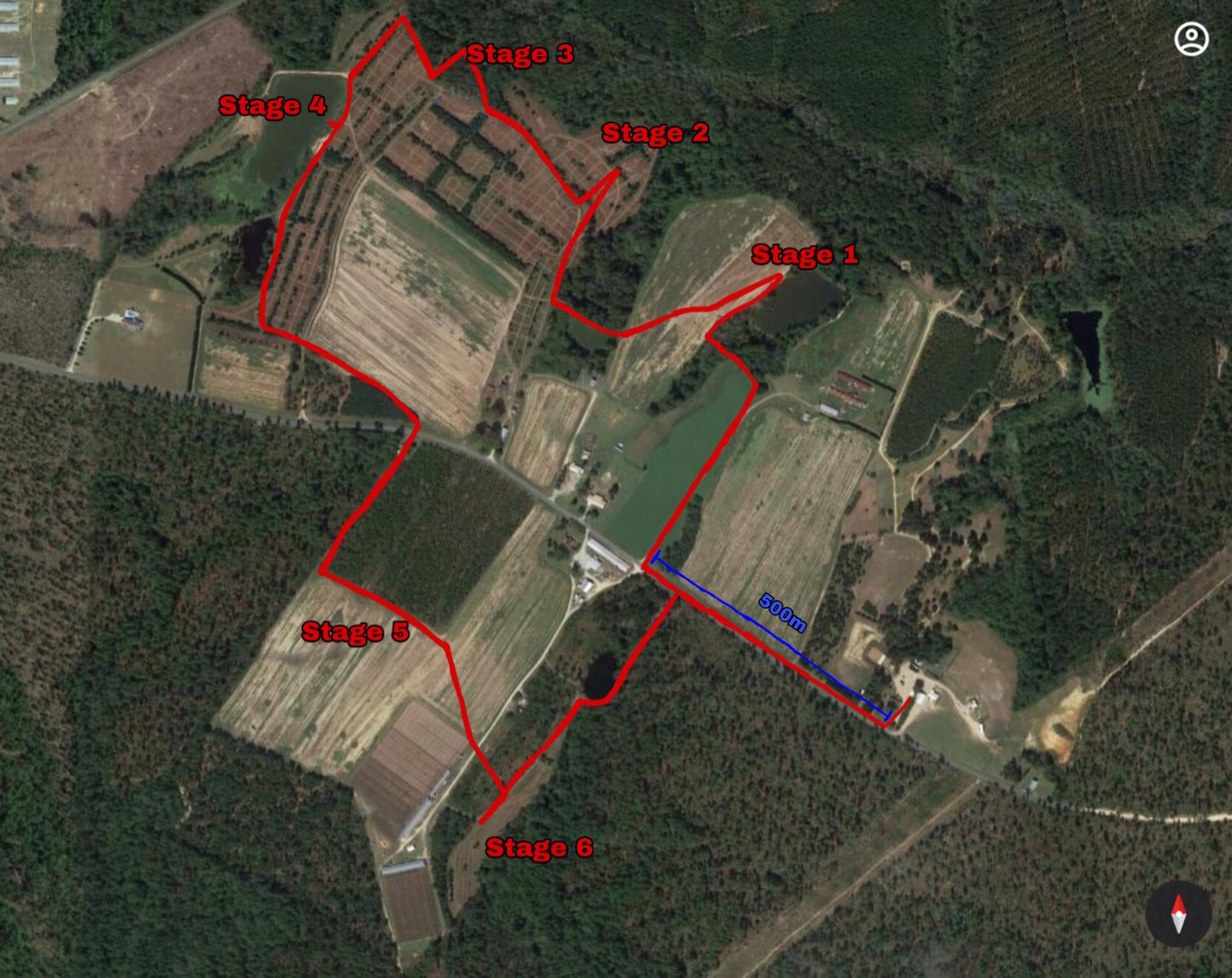
I was warned that these races sold out quickly so I placed a calendar appointment 15 minutes before the tickets went on sale as a reminder, and purchased my appointment with reality the moment they started taking money. There were four options, three time ranges for runners who had previous 5k run times they expected to finish in again, and one option those who intended to walk the duration of the event. I picked the last run range, which in hindsight was rather ambitious.
A YouTube channel and a few blogs were suggested at the event website, and they were my first sources. Kit is a very personal matter, and my antecedent education already had me imagining a light kit setup so I only needed to make some modifications and further purchases. Based on what I could find from the Internet and those content providers' previous race experiences, I took my ideations and pocketbook to the market.
I ended up with a good initial setup that honestly performed great for what I expected, although a bit much after AAR. My initial clothing setup and weapons were based on what I had, and the terrain I was expecting. There were no mistakes made here. Of course a kit post was made on Twitter.
Clockwise: Born Primitive MC Black short sleeve
— Ƒʉͫcͧкͭιͪηͣ 𝙶𝚛𝚞𝚗𝚝𝚙𝚊 👴 (@th3v0t4ry) April 9, 2021
SoLGW EXO2 w/ EOTECH Vudu & Vortex Venom
Glock 23
Safariland 6390 w/ 6072 & QLS
Blue Alpha Gear EDC belt
Salomon Speed Assault boots
Darn Tough Light Hiker Quarter lightweight socks
prAna Stretch Zion
Apple Watch S6 in Catalyst case
The shirt was a great athleisure four way stretch, that matched my fascination with GothPat. I've run the rifle for some time, although he LPVO and canted RDS is somewhat new. My Glock and I have been married for a decade and a half, and like any Glock is not exceptional beyond the brand's known reliability.
Safariland holster and the belt are something I wear and carry every day. The boots were new but broken in, and would be crucial. Darn Tough socks have become a new fascination of mine, and are well worth the big money price tag. I have also recently begun to wear prAna pants nearly exclusively. They really are the most comfortable pant ever created for men. The watch and case/band were really more of a race control unit for other equipment, and honestly was a really convenient bit of gear for the race, as will be described further in a bit.
Clockwise:
— Ƒʉͫcͧкͭιͪηͣ 𝙶𝚛𝚞𝚗𝚝𝚙𝚊 👴 (@th3v0t4ry) April 9, 2021
VelSyst UW Gen IV
Walker Razor XV
Hydrapak Hydrasleeve 3L
Gorilla Tape
Leatherman 300M
Qik-Labs towel
Hatch gloves
Garmin Foretrex 601
STNGR Alpine
Inside:@solatac BOK & tourniquet
Vortex Impact 1000
Not pictured:
iPhone Pro Max 11 w/ LifeProof case
Most of everything listed above was fine for a different setting, but for the race I could have been much lighter. The chest rig functioned extraordinarily, but the match round counts were 40 rifle and 35 for the pistol. Even with 2o round magazines I was at twice the ammo count just in the rig, and I even carried an additional rifle magazine in the Eberlestock mini backpack. This chest rig also held five pistol magazines, and I carried two additional pistol magazines in the pack. This was entirely too much ammo. Total round counts for what I brought in were 91 pistol rounds and 100 rifle magazines.
I finished with 58% and 57% rounds unexpended for pistol and rifle, respectively. First lesson learned: Trust the provided round counts. I only have this first Gun Run to go off of, but I will put more faith in what they suggest next time. I understood correctly that misses generally don't count against you, but the truth is misses are a waste of time, which like in life is your most precious asset. It simply doesn't pay to try to shoot when you aren't on target or are unsure of a hit. Extra ammo is prudent, to a point, but don't overdo it.
The Walker headset was phenomenal. I noticed when playing with it before the race that I had to be careful getting a cheek weld or adjusting backpack/chest rig straps, but otherwise it was perfectly suited for the race. As a bonus Walker has an iPhone app and Apple Watch widget, which allows for you to change the frequency modulation, earpiece ambient volume adjustment, and sleep timer. I tended to adjust to the "Voice Detection" setting when getting range instruction and "High Frequency" during shooting to be able to detect the ring of steel targets for a slight edge, instead of relying on hearing the ROs shout "hit." Not really a required item but definitely a nice to have.
The Hydrapak bladder was fine, but filling it with 3L of water was stupid, and I really knew better. I was afraid of running out of water, but in hindsight having a liter per kilometer was very stupid. The bladder is graduated and even after some post race sipping I was nearly at 1.5L of water left by the time I came home. Next time 2L will be the max for this distance and temperature. You really don't have a lot of time to drink water if you're moving fast enough.

The rest of the items save the sunglasses and the Garmin were taken out of precaution but were not used. I did suffer a small cut on my weak hand, which bled some but still weren't worth wearing the gloves. If the round count was higher and barrel temperatures increased I might reconsider, but in hindsight I didn't wear them or need them really.
Second lesson learned: For longer races a chest rig will be handy, for a low round count 5k, a battle belt could suffice. I think a belt with two full, standard capacity rifle magazines, and four pistol magazines would be well balanced. Adding the backpack with 2L of water would be just right.
All the gear discussion dispensed with, the race was well organized and the attendees a friendly and fairly heterogeneous mixture of people. You show up, check in at the desk, confirm your start time and wait for your cohort's safety briefing. My briefing was conducted by the race organizer Ellis Domenech, who is well known for his writing at the Federalist. He gave a great description of the conditions and concerns regarding the event, afterwards I went back to shoot the bull with friends until we each started.
When my starting time approached I donned my gear, powered up my optics and conducted my PCCs and PCIs. This was done under the cover of shade which should provide the appropriate foreshadowing for a lesson learned later. When the race clock came to my time I took off down the road.
The initial jaunt was rather long and featured the first water obstacle, just at the end of blacktop and sandy roads. The water was waist deep and the mud over boot laces. Thanks to the safety briefing I had tightened laces in preparation for it. Coming out of the water I found the first stage close.

Stage 1 "The Active Shooter":
12" x 20" torso at 85yd, 10" diamond, 8" circle
On the beep you will close the distance as much as is needed to make two consecutive hits on the active shooter target (no closer than the stakes). If the first or second shot misses the target, shooter will have to transition to the smaller target, and again close the distance as much as is needed to make two consecutive hits(no closer than the second stakes). If any shot misses, the shooter will transfer their pistol to their weak hand, move to the even smaller circular target and again close the distance and make two hits with their weak hand only to incapacitate the active shooter. 60 second time limit. If you shoot innocent bystanders you will fail this stage.
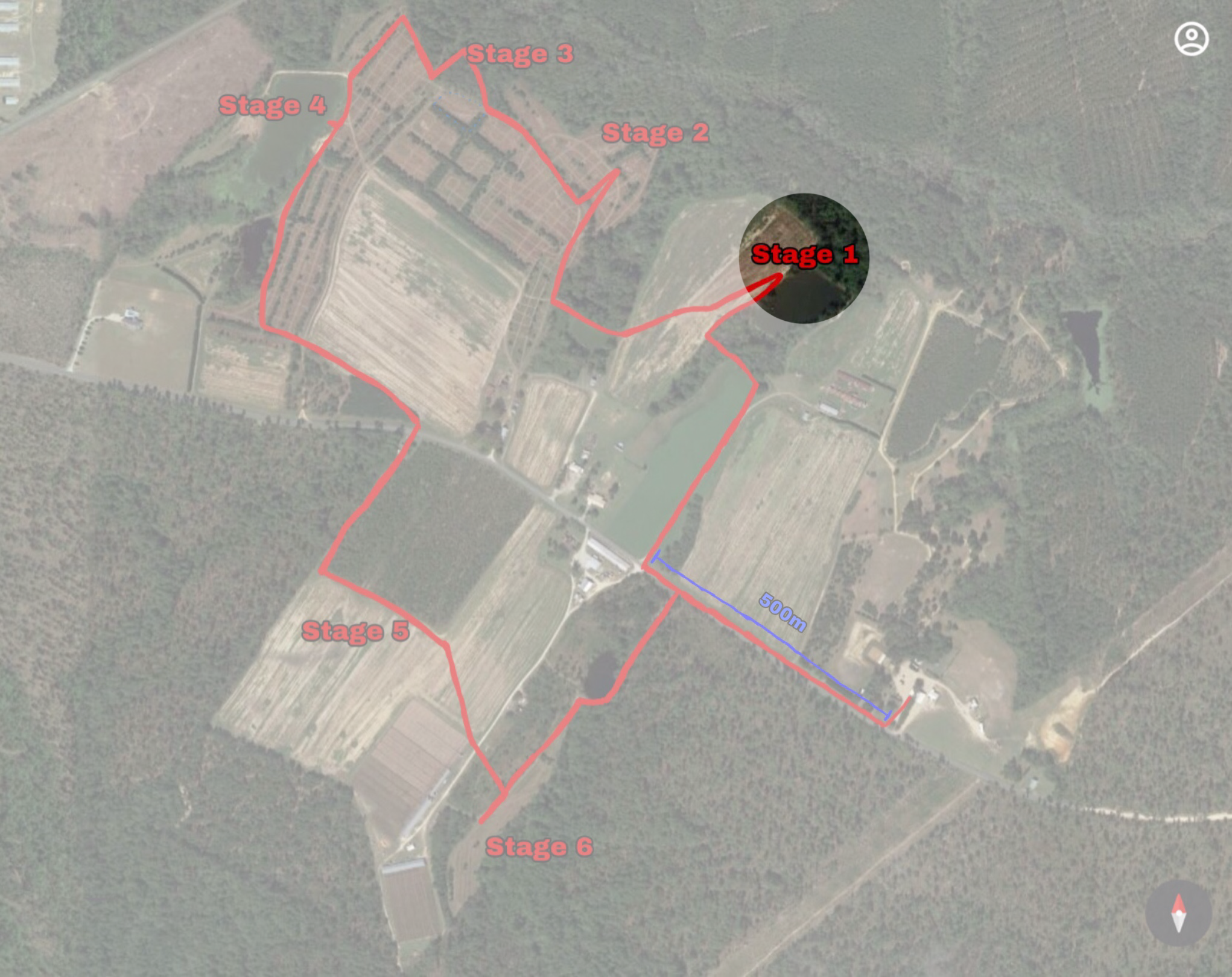
I came into this stage way too cocky on my pistol capabilities and a little smoked from running straight into it. I should have also paid closer attention to the briefing. Third lesson learned: Take the time to make the shot you KNOW you can make. In this competition you need to listen to the task, conditions, and standards. In this instance I ran to the first target and drew and quickly fired, which was a miss. This forced me into the next target where I quickly drew and fired, resulting in another miss. That forced me into the last target where I had to fire with my weak hand, unsupported. This was a ton of time wasted for shots I know for a fact I can make easily if I slow down. Fourth lesson learned: Don't run into the station. Take a little bit of distance to get your gear ready, prepare your mind to listen to the stage briefing, and gather your breath or slow your heart. It seems like a prodigal waste of run time but the stage time rules your shooting and is much more precious. Make sure you show up to the stage briefing as prepared as you can be.
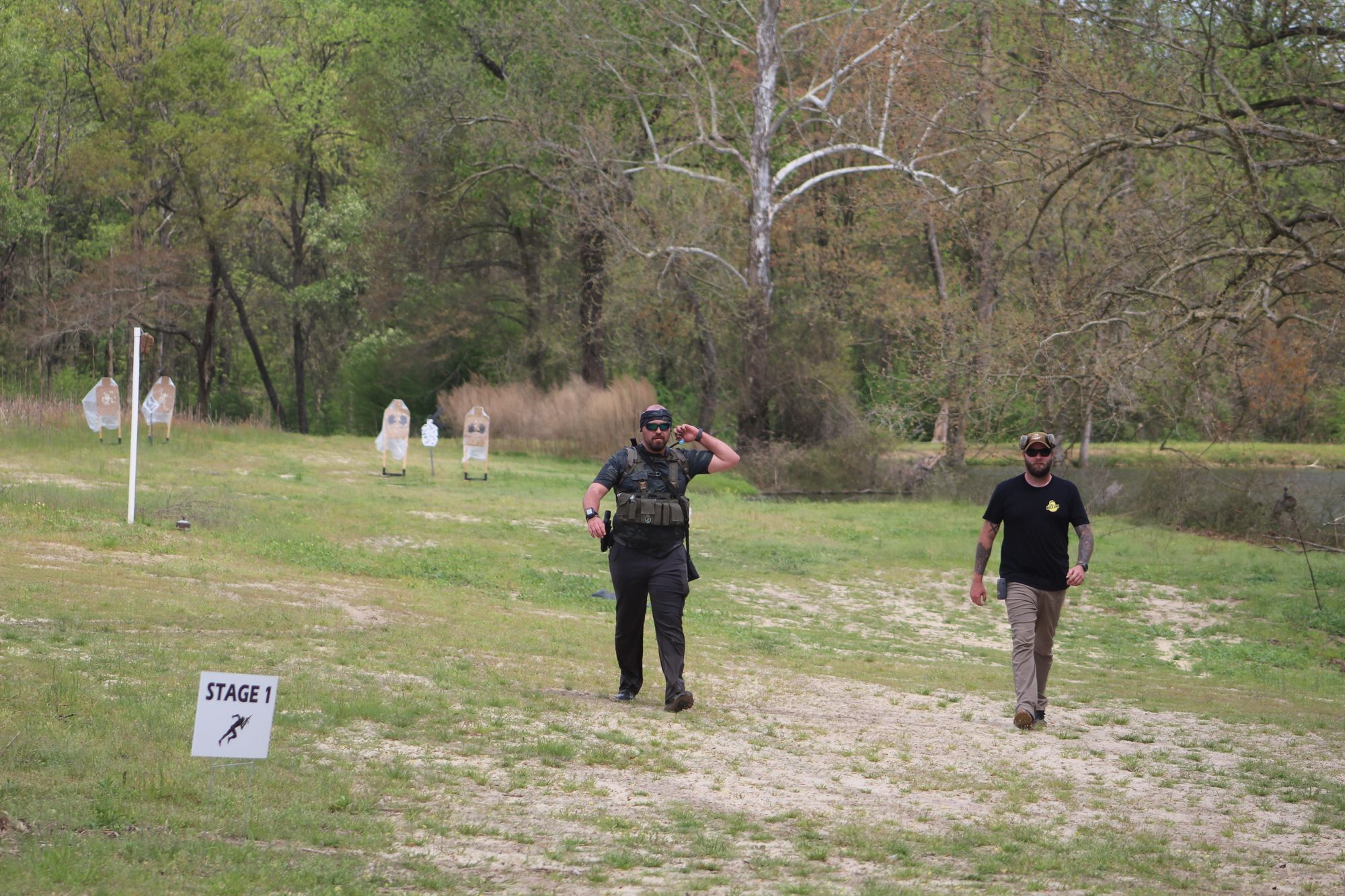
Stage 2 "The Tree House":
Four 12" x 20" torsos at 50, 100, 125yds
On the beep, shooter will scan their sector and engage enemy targets with three hits each. You may use the supplied range card to ensure you observe all enemy avenues of approach. 90 second time limit.

Showing up to this stage I immediately knew it was shooting from an elevated position as there was a plywood box in a tree with a ladder lashed in place. I showed clear on the rifle and took the trip up making sure to scan for targets when I arrived. The range brief was read to me, I was given the range card, and was told to prepare. I heard a lot of folks used the ladder or other improvised rests here but I went with my rifle bipods, extended to half of max height, and loosened the knurled knob on them so I could take advantage of the pan and tilt capabilities of the Axis model I was using. You couldn't stage a magazine under the weapon but I just placed one inside my front pant pocket. When the timer went off I loaded and closed the bolt and began to snap quick three round bursts into each silhouette. This run felt good. The RO told me he thought it was an exceptionally fast run and I ended up taking third place over all here. Again I took my time at this stage and by preparing and mentally rehearsing I saw dividends.
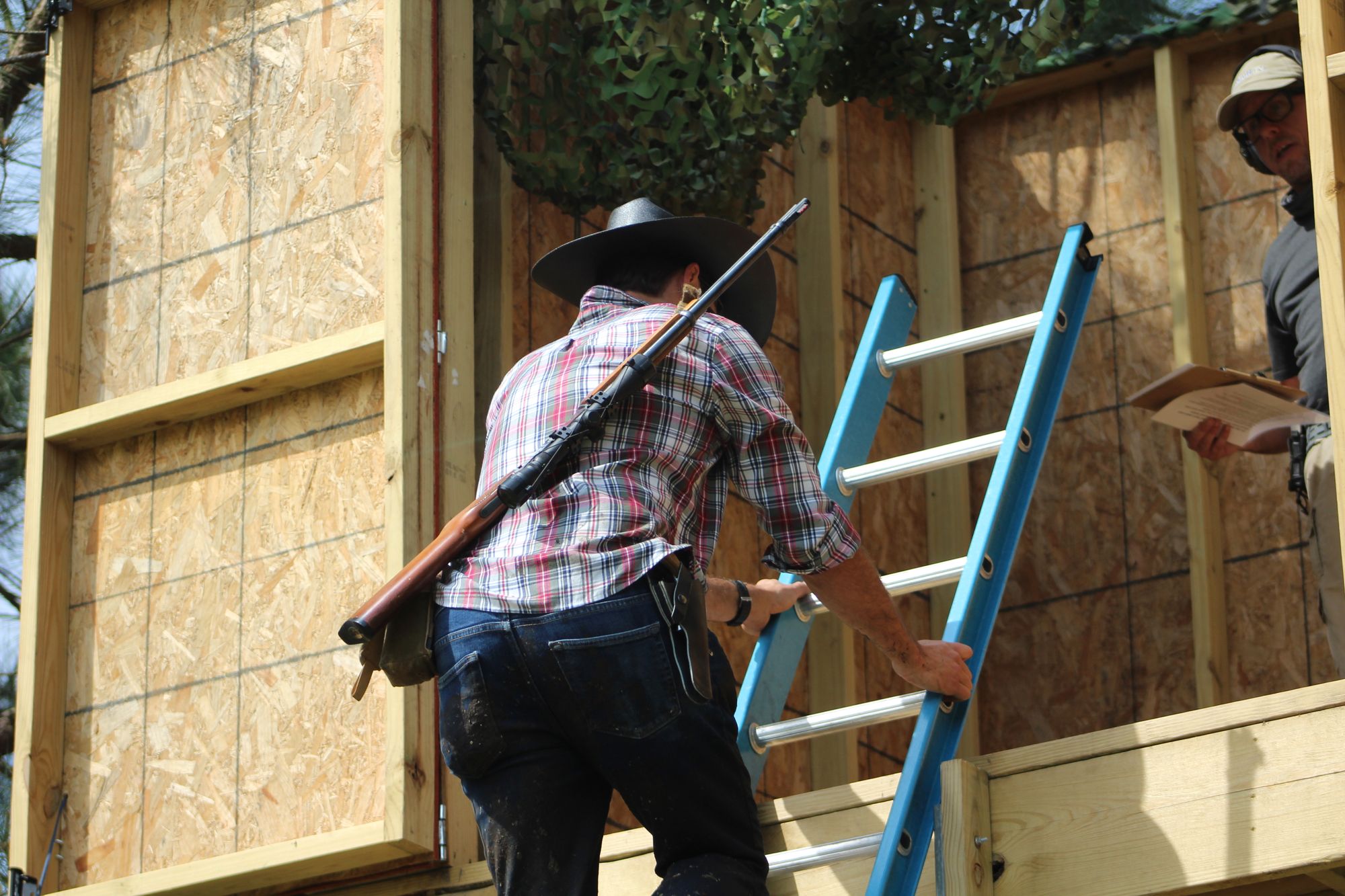
Stage 3 "Rescue Randy":
Point blank paper, 3 sets of 10" and 8" Mozambiques at ~10 yds
On the beep, draw your pistol and shoot the close (point blank) target with four shots. Holster pistol and rescue Randy by dragging him to cover, then make your way to each barrier and use your pistol to shoot all targets with two to the chest and one to the head. 90 second time limit.
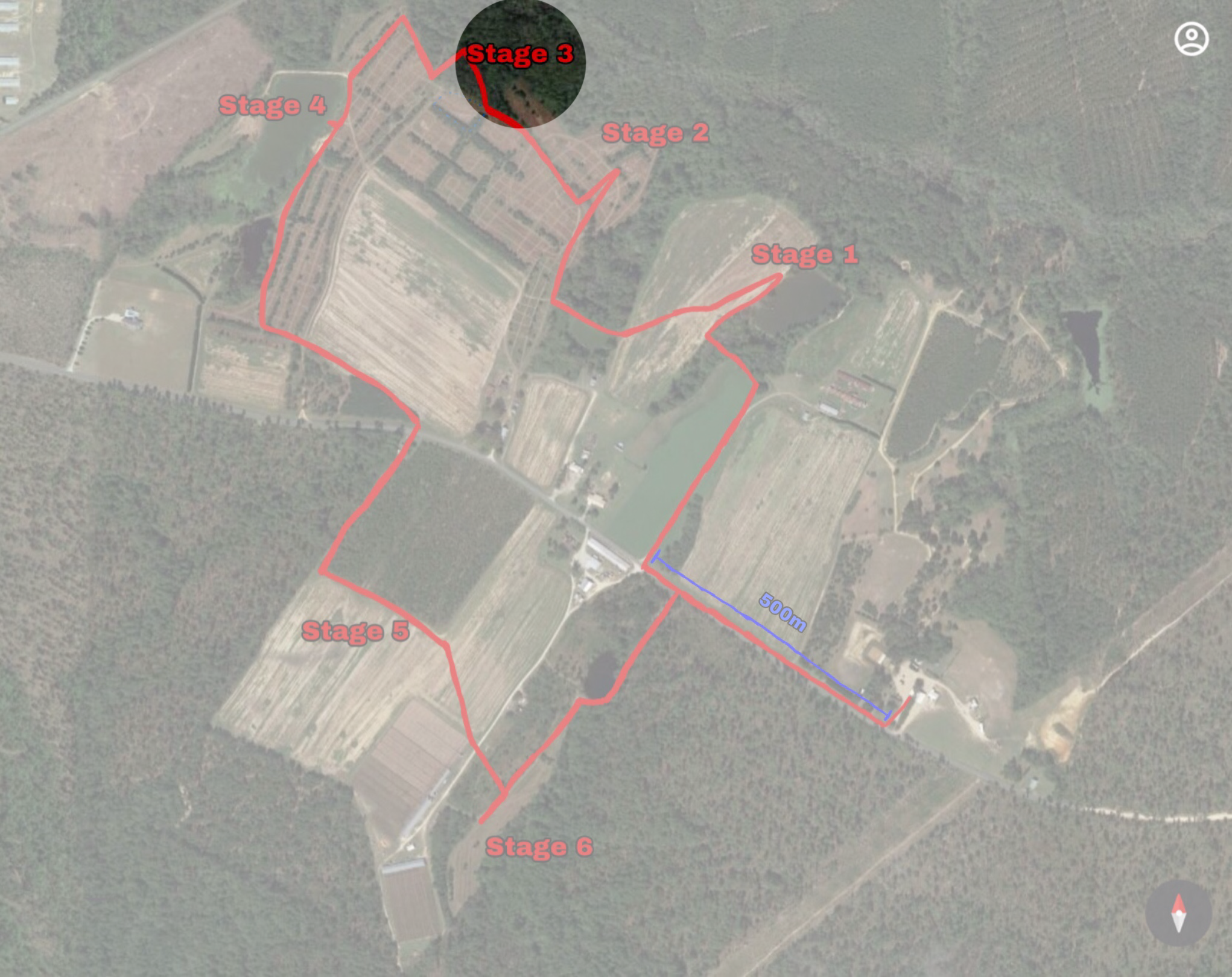
The range briefing doesn't mention that immediately before starting you are issued a weighted duffle bag and sent on a circuit that is ~150 yards of pine straw and sand. I can't be sure but I think the duffle was somewhere around 80lbs. It wasn't entirely filled and the weight seemed evenly distributed on each end. I threw it over my firing shoulder and took off. I think in hindsight wearing it like a saddlebag over the neck would have been a better option but it didn't prove too difficult. When you returned with the duffle you were given the above stage briefing.
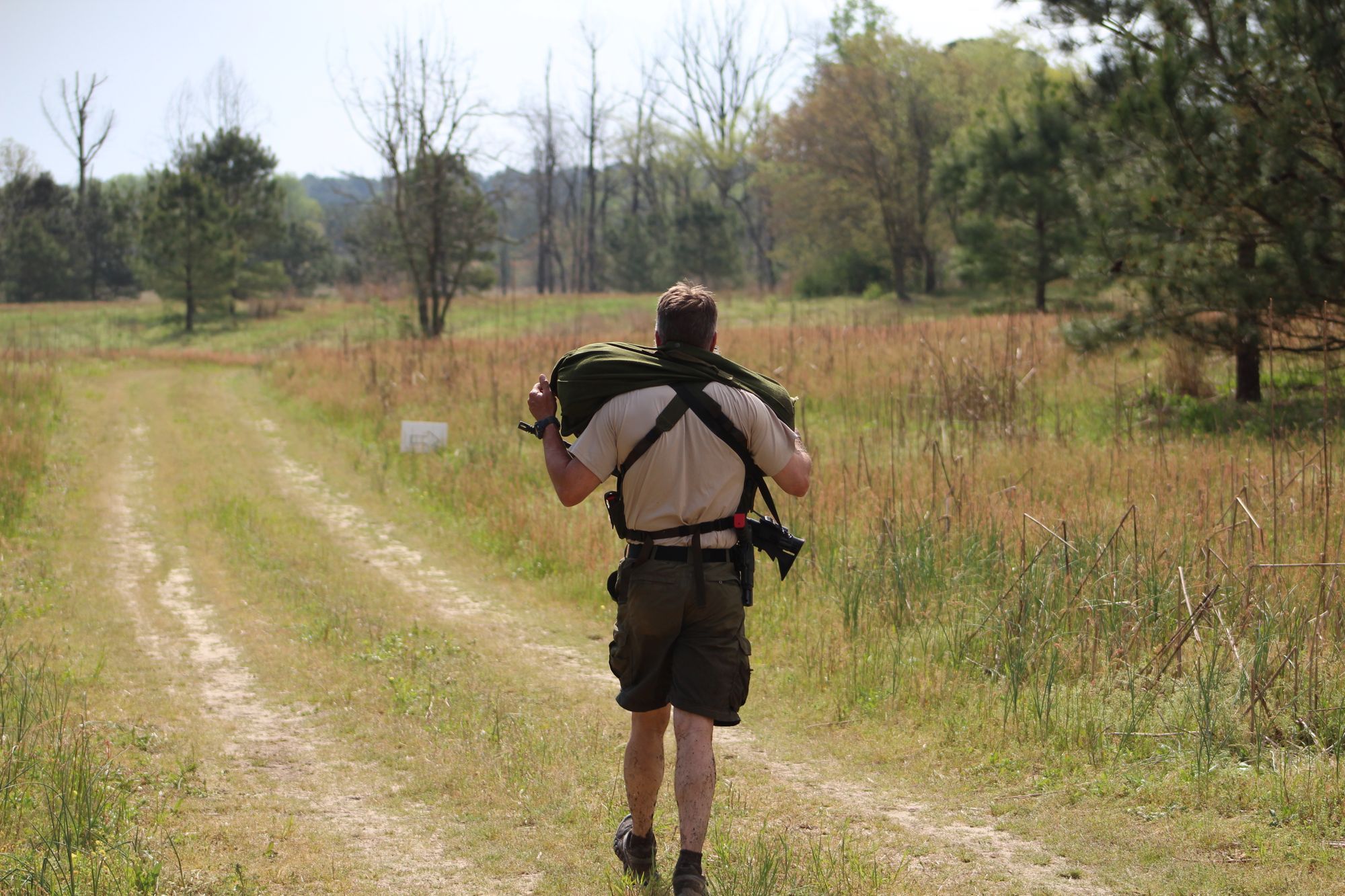
On the draw I didn't even raise my pistol above my sternum. I practice a lot of these point blank shoots and just cleared the holster and dumped my four rounds, then re-holstered to go get Randy. Now I have no idea how much he weighed, but I'm thinking he was at least 150lbs. I had him feet toward the intended cover so first attempted to take him like that but it was a piss poor plan. I had to abandon this early and just grabbed him by his plate carrier and drug him to his place of cover. Fiddling with his feet cost me time and being aware of this I really put a lot of effort into making up the time by pumping legs and moving fast. As soon as I got Randy to his cover I sprinted to the Mozambiques. I think I might have only missed once but maybe not at all.
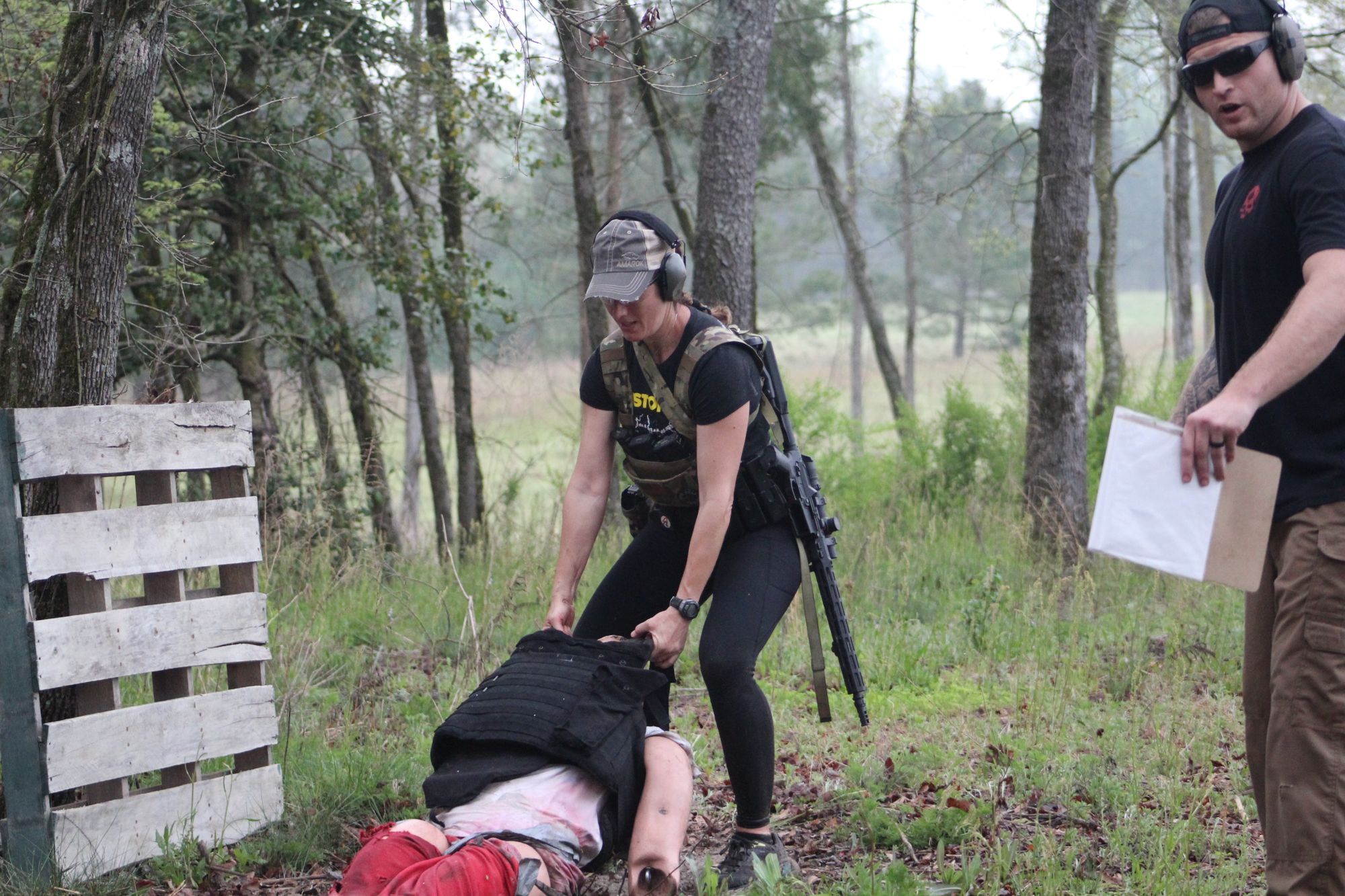
When I was cleared off the range the RO told me I did well just in time for me to puke up the little bit of water I had ingested prior, which let me know I put a lot into this stage and that I needed to better physically prepare for these types of events.
Stage 4 "Ammo Resupply":
8" circle at 100yds, 10" diamond at 110yds, 10" diamond at 125yds
On the beep, you will engage the targets across the pond with one hit each. Then move the ammo resupply to the defensive position in front of you, where you will engage again with one hit each but from your weak side. 90 second time limit.
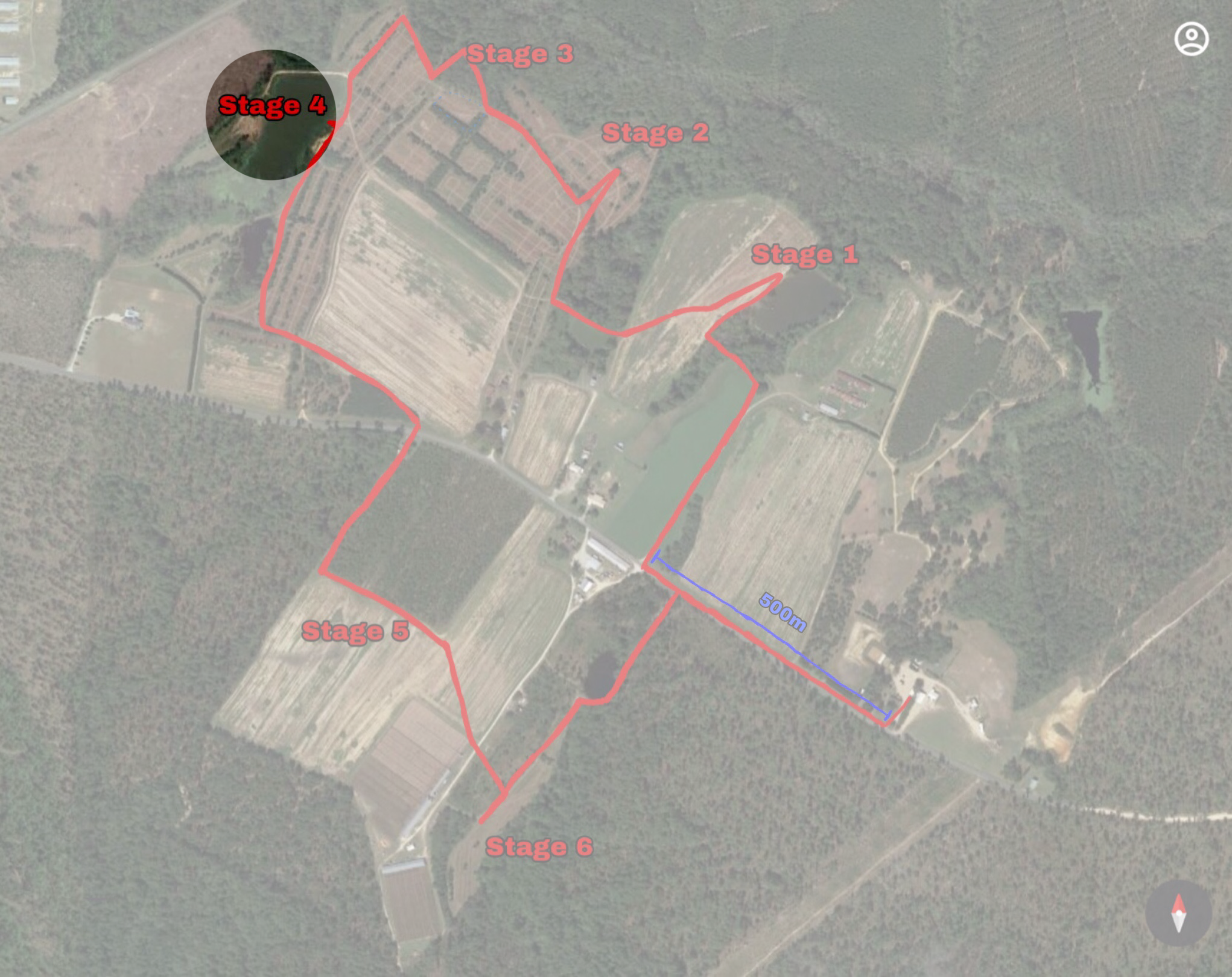
This stage was DNF'd by something close to 69% of the shooters. I can't speak for everyone but the weak hand shooting at these targets and distances just isn't trained for by most shooters. I really kicked myself after this stage.
So before it began there was an obstacle, a high crawl through sand under barbed wire. I think it was about eight feet long and the ware was over three feet high. It really wasn't difficult but I did see some blood spatter near the end, which makes me think someone had some trouble. Once you passed through this the RO read the brief, which sounds simple enough. Again I knew now to take my time on setup. The targets were actually at a higher elevation than I was on my side of the lake, so I extended the bipod fully and placed it on top of the "ammo resupply" which was one .30 caliber ammo can.
At this level I was even with the targets while prone. I was able to load before the RO asked for a ready so once I was on target I was able to begin. Three easy hits. I left the bipod down (mistake number one) and headed down to the shore to a brush pile. Getting there I tried to set the bipods on the brush only to find that I couldn't get both legs settled. Each would punch through the brush or slip off the log when I would readjust. I also was trying to get some sight picture. My canted RDS was what I was looking for but I just couldn't find the dot. I was moving my head around in a circle but I just couldn't see it. I finally lowered my point of aim toward the water, which was a much darker contrast and that is when I saw my second mistake of the stage, the red dot was on a low power setting. Fifth lesson learned: Turn your backup RDS on the max setting when shooting in full daylight conditions, or at least conduct PCCs in similar conditions to those you will be competing.
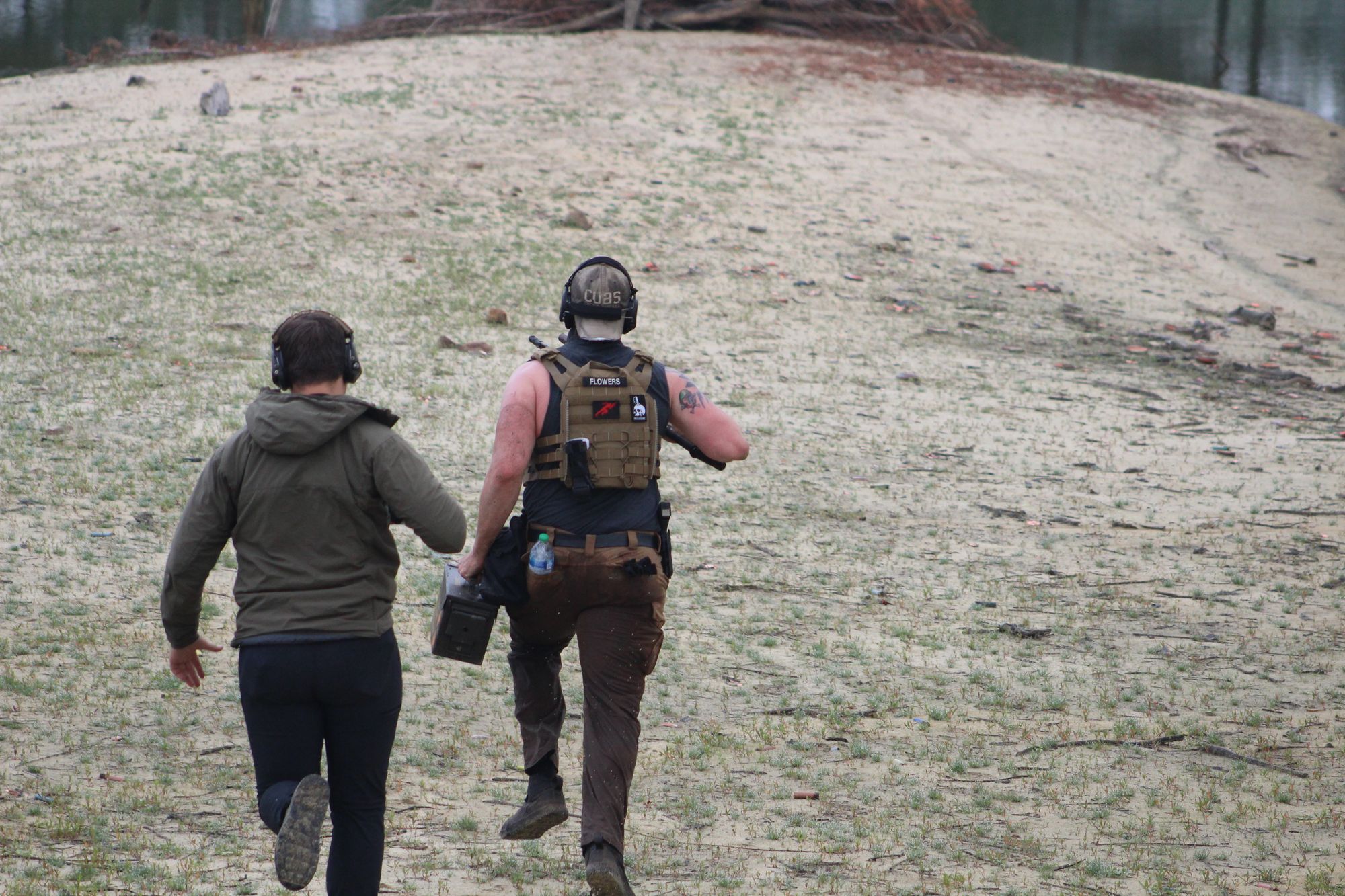
Abandoning the idea of using the canted RDS I went with my LPVO, which I still had turned to the highest setting. This unfortunately makes the eye box into a very narrow region that just seemed impossible to find with my non-dominant eye. Realizing this I cranked it down to 1x and began (finally!) to engage these targets which are admittedly about 25yds closer than before. I managed to hit two out of three before my time ran completely out.
I'm not going to lie, this one hurt pretty bad. I had practiced offhanded shooting since Iraq when my unit made the practice SOP, but only with unmagnified EOTECHs and RDSs, and never at a canted position. After converting this rifle to it's current LPVO w/ canted RDS setup I focused only on shooting with my strong or dominant hand. I just wasn't physically or mentally prepared for this, and I should have been. I will be next time.
Stage 5 "Car React to Contact":
10" gong at 115yds, 12" gong at 280yds
Start in the vehicle with your empty rifle in the passenger seat, cell phone in one hand and one hand on steering wheel. On the beep, you will dismount your ride, load your rifle, and engage the two saw horse targets with one hit each then repeat once more. 90 second time limit, if you shoot your ride you fail this stage.
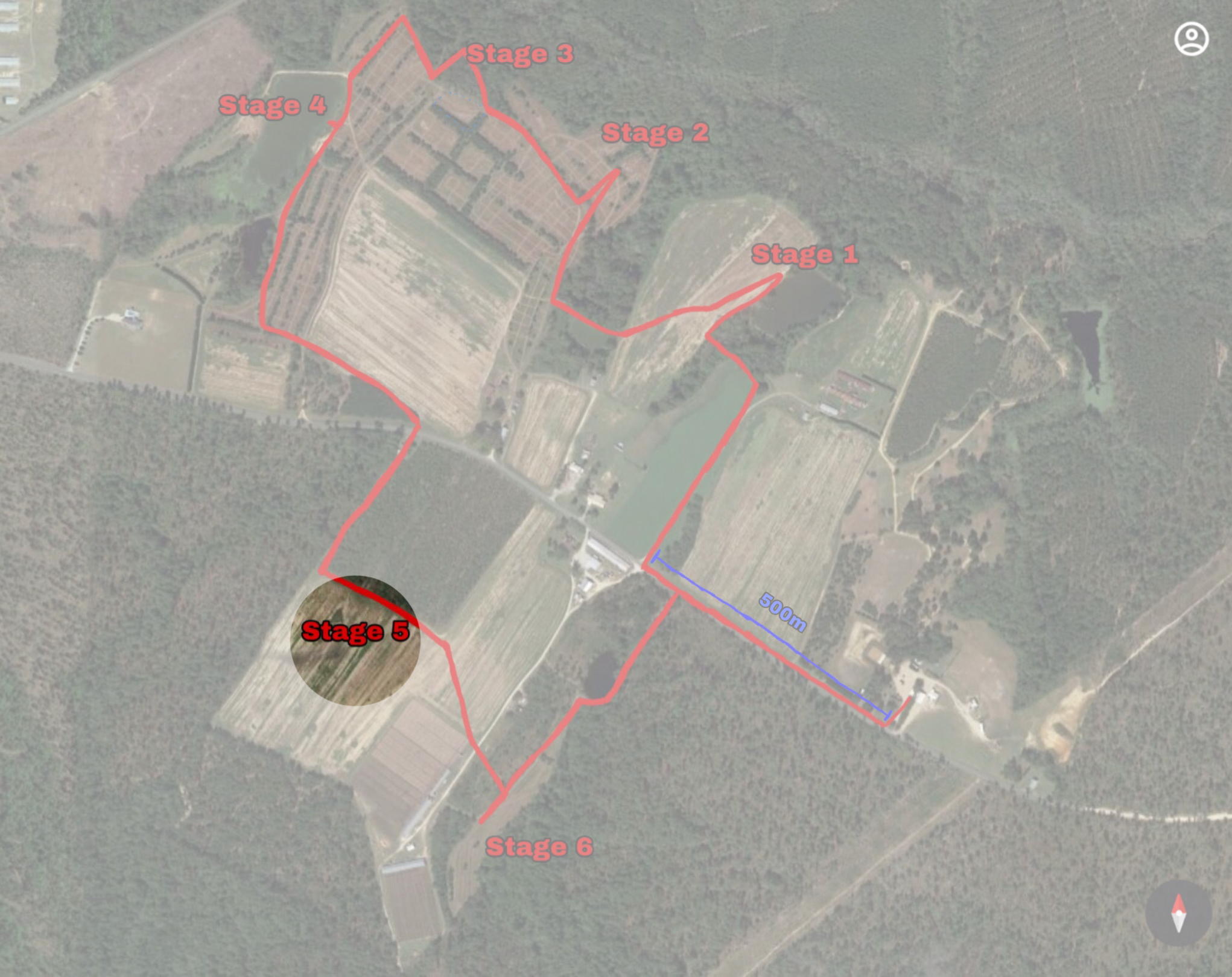
This was my favorite stage even though my performance wasn't ideal. The cell phone and steering wheel in hand was a good touch. Getting out of the car was a little difficult as it was low to the ground (which I'm not accustomed to) and my rifle sling got caught on the emergency break handle located between the seats. Once I was able to get out with the rifle I loaded a 20 round magazine and used it as a monopod on the car roof. I'm unsure how many rounds I fired. I think somewhere around my second miss on the furthest target I dialed up 2.5 MOA. This put me where I wanted to be and I got that hit, the one near again, and the further target once more. Speaking with other shooters I heard use of bipods and other parts of the car as a rest. I would like to get more practice using vehicles. The more I think about it using the car as cover versus concealment should have been a factor in my decision, but this was only a one way range so it just didn't cross my mind during the event.
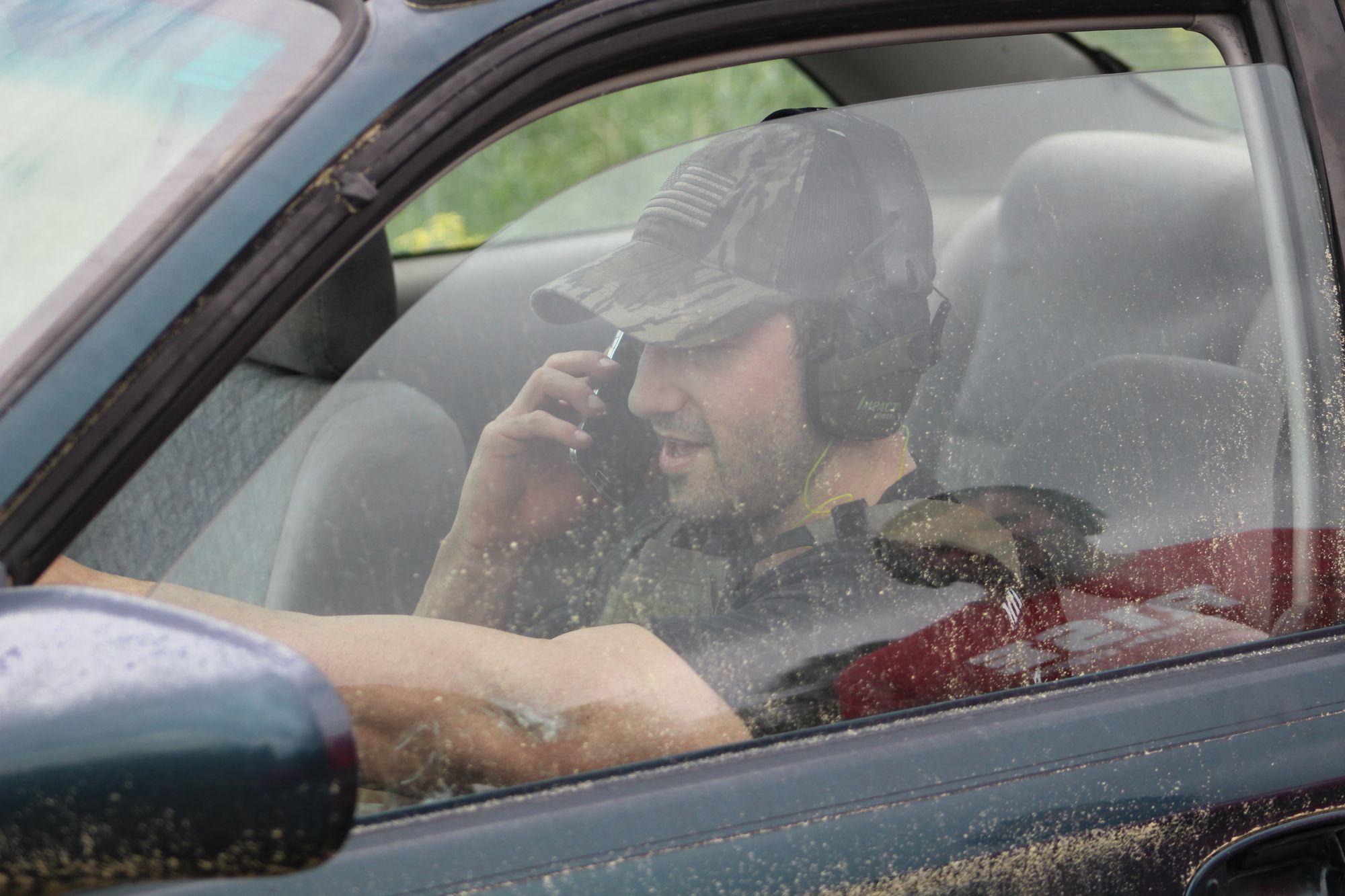
Stage 6 "Rifle to Pistol Combine":
12" x 20" torso at 110yds, dueling tree at 10yds
6 hits from kneeling position, then rifle on safe and grounded. 6 hits on dueling tree. Then one bonus shot with blackpowder colt for 2min off run time.

By the time I saw this stage I could definitely smell the barn and was ready to finish. The kneeling hits at 110 were no issue at all and I made the dueling tree hits with the pistol without too many misses. I barely missed the blackpowder SAA shot, which disappointed me mucho as I had just left Idaho a few weeks before where I shot them extensively at distance.
Leaving this stage I think there was something like 600 meters of running as the crow flew, but it was somewhat circuitous and included one more water obstacle consisting of a dip in the lake with a tow strap for a handrail. I did my best to run it in as I knew we didn't have any more shooting stages.

The crew running the event were bringing everyone in with clapping and cheering and it was a nice touch, as anyone around would join them. They cleared weapons and I was able to join some friends who had finished before me. We swapped stories and tactics for a bit until the rain caught us where we went back to the awning for shelter.
The last runner came in sometime around 1745, and there was an award ceremony and rifle held about an hour later. The crew running the event was great, and the prizes were legitimately good items. I was able to snag a slide milling and Cerakote finish gift certificate, but there were even better prizes handed out before mine such as scope mounts, steel targets, and a Vortex Strike Eagle. The atmosphere was familial and Ellis did a great job making new competitors like myself feel welcome.
The Gun Runs are probably something I am going to attend much more in the future. Unlike three gun competitions or others I feel like this is a realistic-ish challenge that pushes you physically as well as mentally.
